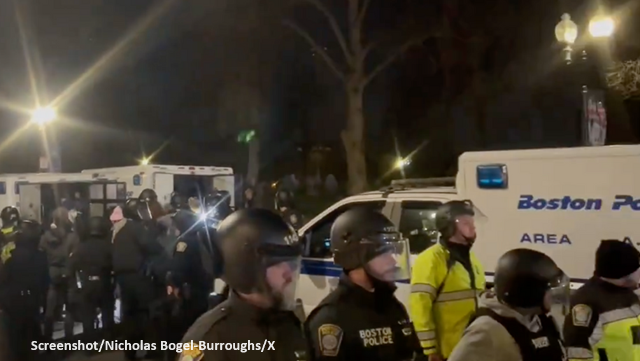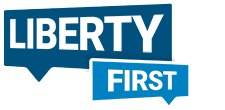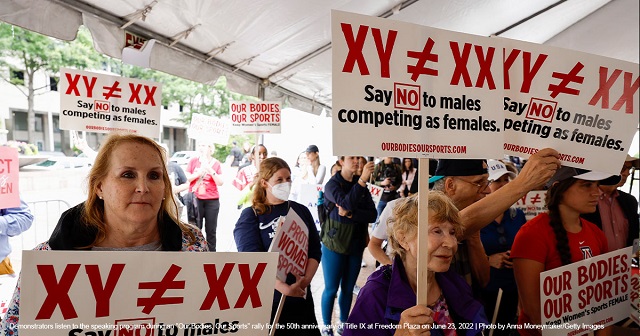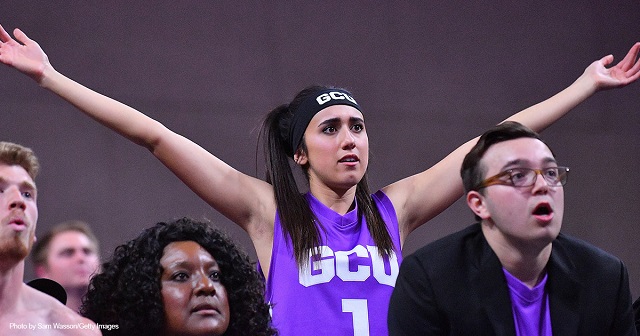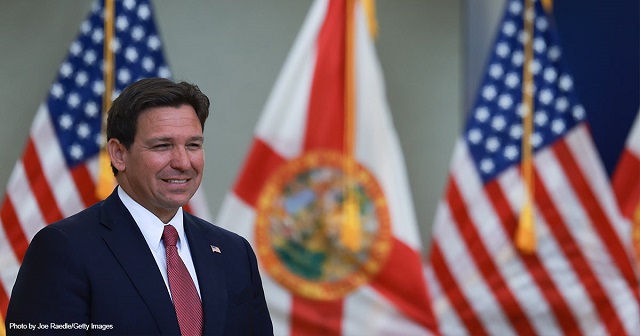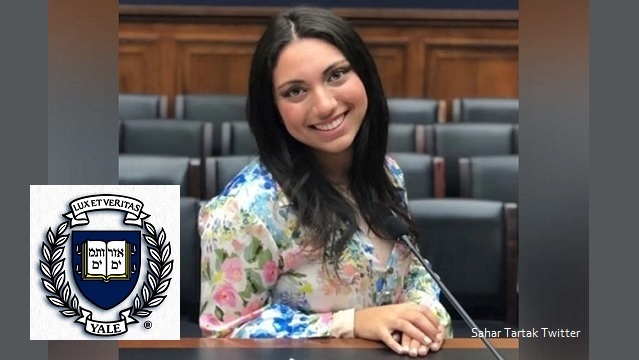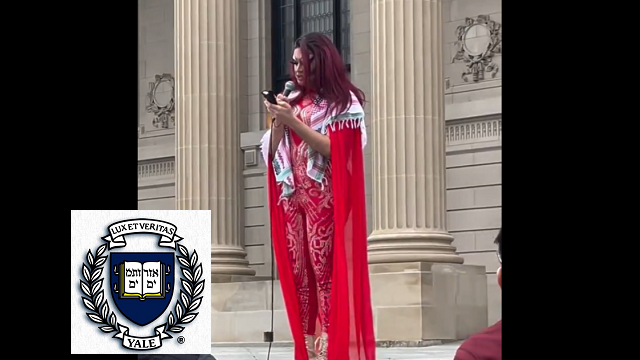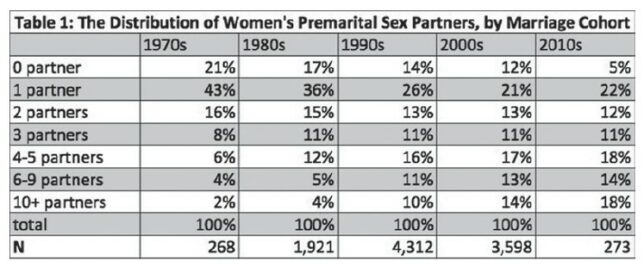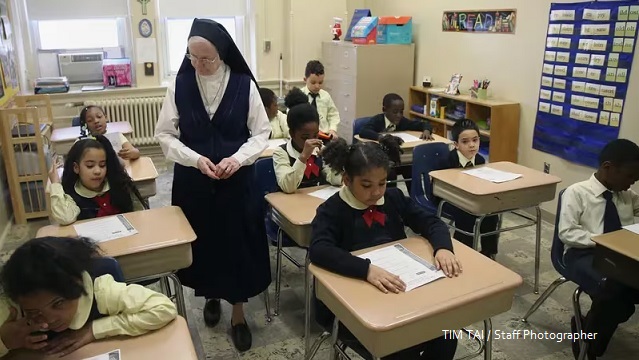
President Joe Biden summed up his education vision last year with a few words.
“There is no such thing as someone else’s child. No such thing as someone else’s child. Our nation’s children are all our children,” Biden said while honoring the 2023 teacher of the year.
Biden’s remarks triggered a firestorm among Republicans, education activists and parents alike.
Now those Biden critics are strategizing for a potential second Trump administration. Priorities have been outlined, shortlists have been drawn. Some are preparing to join the administration.
But it’ll be up to Trump to make his pick for the unheralded but critical cabinet spot of education secretary.
“It’s pretty much impossible to overstate the importance of the education secretary. Not just to Americans today, but to America’s future,” Angela Morabito, spokesperson for the Defense of Freedom Institute, told the Daily Caller.
“It is not a secret that our country is falling behind while we’re spending more per student on education than nearly anywhere else on Earth. And yet, our results are mediocre to put it generously,” Morabito said.
There’s been no shortage of anonymously sourced conjecture on who might take other cabinet roles. But the Secretary of Education has flown under the radar despite being a hot-button issue for Republican voters — and a position that influences the future of the country in a way that’s unique from any other.
The issue of education has exploded into the spotlight during Biden’s term after accelerating at a slow burn during the Obama years, which prompted a pendulum swing under Trump. Conservatives now have a set of priorities ranging from reeling in Title IX to rooting out bias from academia and teacher training.
The COVID-19 pandemic forced students into their homes and onto their computers for months of remote learning. In the summer of 2020, the killing of George Floyd sparked racial outrage throughout the country. In response, higher education institutions raced to affirm their anti-racism and diversity, equity and inclusion (DEI) bona fides.
The takeover runs deep — in just a handful of years of full-blown DEI capture of higher education, universities have churned out a generation of insubordinate anti-American bureaucrats, Orwellian tech overlords and a protester industrial complex. The ideological opponents of conservatives virtually all share one common trait: they were trained and equipped on American college campuses.
FLASHBACK: At an event just two months after 9/11, Columbia University’s current president Minouche Shafik remarked that terrorism “is a form of protesting” pic.twitter.com/UkSP4iqDZu
— Brent Scher (@BrentScher) April 22, 2024
Colleges and universities across the country implemented racial quotas, dropped standardized testing requirements and added segregated graduation ceremonies all in the name of DEI.
“I think, looking at all the DEI programs in higher ed is extremely important and starting to deny funds to colleges, who do the DEI programs. That way they either have to scale them back as we’re seeing some state schools doing like Texas and Florida, they’re scaling them back to stay there and try to hide the program or there’s abolishing the program altogether. But either one is incredibly important,” founder of the 1776 Project PAC, Ryan Girdusky, told the Daily Caller.
By 2023, the downstream effects of DEI and remote learning brought communities to a boiling point.
In K-12 education, a grassroots movement was born. Parents had become exposed to what their children were learning at school as lessons took place in the living room via Zoom. Concerned guardians cried out against critical race theory (CRT) lessons teaching students to value each other on the basis of their skin color. Communities sought to prevent their kids from being exposed to literature that could confuse them about sexuality and gender.
But it was too late. In K-12 education, students have fallen grade levels behind in math, reading and civics. Numerous jurisdictions have implemented policies allowing students to use bathrooms and join sports teams on the basis of their gender identity, rather than sex. Other K-12 schools host student clubs on the basis of race and themselves have implemented DEI initiatives.
“The idea of deconstructing, decolonizing math and decolonizing science are coming out of these teachers colleges, to get teachers who are just promoting critical theory in all its forms into K through 12 education. So the teachers colleges are essential place to look at,” Girdusky said.
The Biden administration has pushed many of the efforts rankling conservatives. The Department of Education has finalized a rule that would modify Title IX to protect students from discrimination on the basis of gender identity, a change that would allow boys — identifying as girls — to enter the ladies’ restroom.
On the higher education front, DEI policies have thrown out merit, experience and qualification, all things the nation’s universities were once highly renowned for. Student groups and activities on campuses have been divided into different racial groups. And in the wake of Hamas’ Oct. 7 attack on Israel, college students protested Israel at universities across America, in some cases threatening the lives of Jewish students.
Former Harvard University President Claudine Gay, former University of Pennsylvania President Liz MaGill and MIT President Sally Kornbluth sat in front of Congress on Dec. 5, 2023, fumbling through attempts to condemn antisemitism and explain how their institutions had become a cesspool of hatred.
Here are @MIT students proudly chanting for the genocide of Jews in Israel:
They shout in Arabic: “From the river to the sea, Palestine is Arab.”
MIT’s president, Sally Kornbluth, has resisted calls for her to resign for not protecting Jewish students.pic.twitter.com/FmIbVboUKj
— Shelley G (@ShelleyGldschmt) April 19, 2024
“Our schools can and should be the best in the world. And they’re not,” Morabito told the Daily Caller.
Gay was ousted from her position after conservative journalists and activists uncovered numerous instances of alleged plagiarism in her academic writings. One of those conservative education activists, Christopher Rufo, told the Caller he’d like to see the next education secretary pursue an aggressive anti-DEI campaign nationwide.
“I think the next education secretary should be very aggressive in withholding or even terminating expenditures to universities that don’t meet a basic standard of fairness, equal treatment and compliance with American civil rights law,” Rufo told the Daily Caller. “This would send shockwaves through the entire public and private university system and start getting some of these ideologues who have captured University bureaucracies to start thinking twice before they administer discriminatory and illegal programs, which they do flagrantly at the moment.”
He added the next education secretary should make it clear to universities that if their policies fall out of line with the administration’s priorities, funding will be stripped.
Transforming America’s education system to meet conservatives’ vision will require the right person running the Department of Education. Numerous current Republican elected officials and activists have interest in the job, if offered, the Daily Caller has learned.
“I think when the country calls you to service, you have to listen. And when the president is looking to assemble a team to advance these ideas, these principles and these policies, he’s going to need the best people he can get. And I think something like that would be an offer that would be very difficult, if not impossible to refuse,” Rufo told the Daily Caller about the education secretary job.
“Me, I would do it,” Tiffany Justice, the co-founder of Moms for Liberty, told the Daily Caller. “I think that there are a lot of other people that I’ve met over the past three years who would be willing to serve in the next administration for the purpose of putting the focus back on academic achievement and meritocracy across America.”
Moms for Liberty has grown into one of the most prominent grassroots organizations advocating for parental rights in the nation’s K-12 schools. Focused on school board races and policies enacted at the state level, Moms for Liberty has become known for its battle against age-inappropriate gender ideology lessons and the implementation of CRT.
Justice added that she has been working with a team of individuals through the parental rights movement that she thought would make good leaders in the education department for the administration, including Florida Education Commissioner Manny Diaz, South Carolina Superintendent of Education Ellen Weaver, Oklahoma Superintendent of Public Instruction Ryan Walters, Arkansas Secretary of Education Jacob Oliva and Florida Rep. Byron Donalds’ wife Erica.
Grassroots activists aren’t the only candidates to lead a potential Trump Department of Education. A who’s-who of elected Republican officials have the support of education groups that spoke to the Daily Caller, and there were indications some might be interested in the job.
One education group listed several current and former government officials on their shortlist for the position, including former Indiana Gov. Mitch Daniels, Iowa Gov. Kim Reynolds, Texas Gov. Greg Abbott, Arkansas Gov. Sarah Sanders, Virginia Gov. Glenn Youngkin, former Nebraska Sen. Ben Sasse, former New Mexico Secretary of Education Hannah Skandera and Louisiana Superintendent of Education Cade Brumley.
“From her perspective, it’s something that she is interested in,” a spokesperson for Reynolds told the Daily Caller.
“Is this satire?” said a former campaign aide for Sasse, who is still close with the now-President of the University of Florida.
Walters, who didn’t indicate whether he would accept the position himself, listed Heritage Foundation President Dr. Kevin Roberts, PragerU CEO Dennis Prager, Youngkin, former Arizona Gov. Doug Ducey and Sanders as his ideal candidates.
“First, I will do everything I can to support and help get President Donald Trump reelected,” Walters told the Daily Caller about whether he would accept the education secretary role if offered.
“I am focused on my role to ensure Oklahoma schools are rid of woke indoctrination, liberal union strangleholds, and reawaken a love for our country. The focus must be on firing Joe Biden and ending the culture for hating America,” Walters continued.
Another Oklahoman, Gov. Kevin Stitt, is “open-minded” about the position, an operative in the state told the Caller.
“I don’t have a firm answer on a yes or no, that he would take it. I do know that his reason that he got into public policy was because of the vitriol he has for the Department of Education and his number one personal goal in life is to see it completely dissolved,” an adviser to Heritage Foundation President Kevin Roberts told the Daily Caller.
Though the Heritage Foundation doesn’t have a formal endorsement for who it would like to see in the administration, there are role models the organization thinks are good examples for the movement.
“I know we’ve had multiple conversations with a handful of the current state superintendents, who I wouldn’t on the record say these are people that we would recommend or who we’d like to see, but people like Ryan Walters in Oklahoma, Manny Diaz in Florida, Ellen Weaver in South Carolina,” Crystal Bonham, a senior advisor to Roberts in communications at the Heritage Foundation, told the Daily Caller.
“They’re all doing work that we have pretty much wholesale endorsed and someone with their kind of character and background that would be ideal, if not Dr. Roberts. Or Lindsay Burke, she’s phenomenal,” Bonham continued.
As for Youngkin, his camp suggested he is very focused on continuing his leadership in Virginia.
“He’s got a clock behind his desk, in his office, in the Patrick Henry building where the governor’s suites are. It’s a countdown clock, because it’s only four years, you can’t run for reelection. So you know, this would all be just speculation. I certainly haven’t heard it. And I don’t know of any conversations that have occurred, but I do know that that his focus is definitely on Virginia,” Zach Roday, a former political adviser to the governor, told the Daily Caller.
The governor’s spokesperson pointed to how proud Youngkin is of his education track record in a statement to the Daily Caller.
“He’s focused on doing that right here in Virginia during his remaining time as Governor,” Christian Martinez told the Daily Caller.
Others are looking back for the best path forward.
“Secretary DeVos would be fantastic — I can’t think of anyone better and more battle-tested for the job,” school choice activist Corey DeAngelis told the Daily Caller. “She would be able to continue the momentum she started when she was at the helm of the department last time. If she is not interested in stepping back from private life again, the next Secretary of Education should be someone who will show a similar commitment to students.”
DeVos provided the Caller with several priorities she would like to see in a second Trump administration, including school choice legislation and undoing changes to Title IX that the Biden administration is eyeing. DeVos did not indicate whether she’d return to her old job, or if she had discussed it with the Trump team.
The Biden Admin has just officially abolished Title IX as we knew it. Now, sex = gender identity.
In a nutshell, the new rewrite means:
– men can take academic AND athletic scholarships from women
– men will have FULL access to bathrooms, locker rooms, etc
– men could be… pic.twitter.com/JfQVI9Yfph
— Riley Gaines (@Riley_Gaines_) April 19, 2024
Girdusky was unsure who he would like to see in the education secretary role, noting that many contenders have a focus on school choice — a topic he thinks should be a priority but not a hyperfocus.
What the next Secretary of Education does will be even more critical than who it is. While right-leaning education advocates have been able to make progress against DEI policies and gender ideology, leading activists had different takes on what the department should prioritize if Trump takes the White House.
But rather than use federal power to enact change to the nation’s education system, some think the best solution is to get rid of what they consider to be the very problem.
“We need to dismantle the Department of Education,” Justice told the Daily Caller.
“Over the past 40 years that the federal government has really inserted its tentacles into every crack and crevice of American public education. And we need to tear it out root and branch so we are working at Moms for Liberty to ensure that we have a lot of advocacy at the state level. And in the counties where local control is so incredibly important,” she continued.
Justice added she wants to rid education of influence from outside agencies such as the Centers for Disease Control and Prevention (CDC).
In addition to dismantling the Department of Education, Walters told the Caller that he wanted the potential education secretary to drive DEI, CRT and transgender ideology out of schools, while also working to take down teachers’ unions.
Above all, Laurie Todd-Smith, director of America First Policy Institute’s Center for Education Opportunity, told the Daily Caller that she hoped a Trump education secretary would close the nation’s learning loss gap that students suffered after the pandemic. Todd-Smith also stressed the importance of undoing the Biden administration’s changes to Title IX.
Pandemic school closures didn’t stop the spread of COVID and resulted in high levels of learning loss for students. | By @BrighamTomco https://t.co/my6cKY1OqH
— Deseret News (@Deseret) April 14, 2024
In Texas, the state legislature has laid out the blueprint for using the government to rid universities of race-based initiatives, like Girdusky, Rufo and others have advocated.
Introduced by Republican state Sen. Brandon Creighton in March 2023, Texas State Bill 17 quickly passed through the state legislature to Republican Gov. Greg Abbott’s desk, where it was signed into law in June 2023. Under the legislation, an institution is not permitted to spend money appropriated to the institution for a state fiscal year until the Board of Regents submits to the legislature and the Texas Higher Education Coordinating Board a report certifying that it has complied with restrictions on DEI.
The Texas law bans DEI offices and initiatives at state-funded higher education institutions. The law also prohibits institutions from considering diversity statements from job applicants and bans mandatory DEI training for staff.
Now, Texas universities are facing consequences because of the law.
In April, the University of Texas Dallas laid off nearly two dozen of its DEI faculty in an effort to comply with the law, CBS News reported. The University of Texas at Austin eliminated 60 jobs and its Division of Campus and Community Engagement (previously called the Division of Diversity and Community Engagement.)
While Justice and Rufo have priorities focused on their expertise, some education activists have a two-pronged approach in mind.
Girdusky said he hoped to see the future education secretary prioritize both K-12 learning loss while tackling issues in higher education.
“But really what there is, is there’s a two-step priority, one is going to be higher ed and the other one’s going to be lower education K through 12. A huge priority has to be to go after the teacher’s colleges. Because a lot of the problems that we’re seeing as far as education goes comes from teachers and colleges,” Girdusky told the Daily Caller.
In the same vein as Girdusky, Morabito expressed that the future education secretary should withhold funds from institutions or K-12 schools that engage in divisive activities.
“The first and the most powerful is federal civil rights law. It is unlawful for any federally-funded program or activity to discriminate based on race or sex, or perceived national origin. So federal funding should not be going to anywhere that discriminates based on sex or race or discriminates against the Jewish students based on shared national origin or perceived ancestry,” Morabito told the Daily Caller.
As for what Trump plans to focus on in a potential second administration, Karoline Leavitt, the Trump campaign’s national press secretary, pointed the Caller to the former president’s already-released education plans.
Under the former president’s priorities for a second administration are several education focused initiatives. To tackle higher education, Trump says he will “fire the radical Left accreditors” and impose standards to remove all “DEI bureaucrats.”
Trump also released his 12-step plan for K-12 education, which would include passing legislation to prioritize “curriculum transparency and a form of universal school choice.” The priorities note that Trump would “keep men out of women’s sports,” an indication that he would undo any changes the Biden administration makes to Title IX.
Several education groups and activists that the Caller spoke with said they had not had any engagement with the Trump campaign about their vision for education.
Leavitt referred the Caller to a December 2023 statement from advisers Susie Wiles and Chris LaCivita on media speculation over transition team efforts. The statement, Leavitt said, makes it clear “that outside groups do not reflect official campaign policy or strategy.”
“People publicly discussing potential administration jobs for themselves or their friends are, in fact, hurting President Trump…and themselves. These are an unwelcomed distraction,” the statement from Wiles and LaCivita reads. “Second term policy priorities and staffing decisions will not – in no uncertain terms – be led by anonymous or thinly sourced speculation in mainstream media news stories.”
“I think it’s very important that we need an education secretary who is youthful, aggressive, intelligent, and ruthlessly determined to shatter the status quo. And so, establishment figures will no longer make the cut, and even Trump’s ambitious policy agenda on education, he’s going to need a leader who can step in day one, with the courage to get things done,” Rufo told the Daily Caller, also noting that he has a very good relationship with the former president’s policy team.
Girdusky said he asked the Trump campaign about the position around the turn of the new year.
“He had not gotten the nomination at the time and it just wasn’t the biggest priority at the time, which it was probably like, January when I spoke to them, maybe December even. So the nomination process hadn’t even come up. And I was just talking about the idea of education secretary or whatnot, and they didn’t have a list of names. It was a very informal conversation,” Girdusky told the Daily Caller.
Three prominent education groups that the Daily Caller spoke to had not had much communication with the Trump campaign about the issue. DeAngelis, Defense of Freedom Institute and Freedom Works’ education initiative “B.E.S.T’ all told the Daily Caller that they had not spoken with the campaign about their priorities or their short list.
Roberts, while in touch with the Trump campaign regarding Heritage’s transition project, has not spoken with the campaign about serving in the administration himself, a senior adviser told the Caller.
“Not at this point. They do talk fairly regularly. Most of that has to do with Project 2025 and kind of general, kind of getting ready for the transition period. So at this point, they haven’t yet talked about specifics in terms of if he’d be willing to take a cabinet position or if that’s even been offered,” an adviser told the Caller.
The same could be said for Justice.
“I’m throwing my hat in the ring now. How’s that?” she said.
AUTHOR
White House correspondent.
RELATED ARTICLES:
More Universities Jump On Trend Of Holding Race-Based Graduation Events
At Yale, ‘Peaceful Protesters’ Hit Jewish Student in the Face with a Flagpole
Columbia University: Protestors call Jews ‘pigs’ and proclaim ‘We are Hamas’
Columbia University Descends Into Pure Racist Hatred
University of Michigan: ‘Freedom for Palestine means Death to America’
Yale: Police storm campus with riot gear, arrest students at pro-Hamas protest encampment
EDITORS NOTE: This Daily Caller column is republished with permission. ©All rights reserved.
